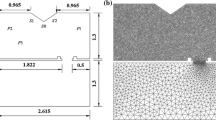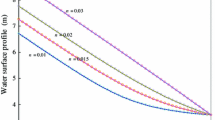Abstract
The purpose of this study is to set up a dynamically linked 1D and 2D hydrodynamic and sediment transport models for dam break flow. The 1D-2D coupling model solves the generalized shallow water equations, the non-equilibrium sediment transport and bed change equations in a coupled fashion using an explicit finite volume method. It considers interactions among transient flow, strong sediment transport and rapid bed change by including bed change and variable flow density in the flow continuity and momentum equations. An unstructured Quadtree rectangular grid with local refinement is used in the 2D model. The intercell flux is computed by the HLL approximate Riemann solver with shock captured capability for computing the dry-to-wet interface for all models. The effects of pressure and gravity are included in source term in this coupling model which can simplify the computation and eliminate numerical imbalance between source and flux terms. The developed model has been tested against experimental and real-life case of dam-break flow over fix bed and movable bed. The results are compared with analytical solution and measured data with good agreement. The simulation results demonstrate that the coupling model is capable of calculating the flow, erosion and deposition for dam break flows in complicated natural domains.
Similar content being viewed by others
References
Frazao S S, Zech Y. Dam break in channels with 90° bend. J Hydraul Eng, 2002, 128: 956–968
Ying X Y, Wang S S Y. Improved implementation of the HLL approximate Riemann solver for one-dimensional open channel flows. J Hydraul Res, 2008, 46: 21–34
Lai W, Khan A A. Discontinuous Galerkin method for 1D shallow water flows in natural rivers. Eng Appl Comput Fluid Mech, 2012, 6: 74–86
Wang G Q, Liu F, Fu X D, et al. Simulation of dam break development for emergency treatment of the Tangjiashan Quake Lake in China. Sci China-Tech Sci, 2008, 51: 82–94
Ying X Y, Jorgeson J, Wang S S Y. Modeling dam-break flows using finite volume method on unstructured grid. Eng Appl Comput Fluid Mech, 2009, 3: 184–194
Liang Q, Marche F. Numerical resolution of well-balanced shallow water equations with complex source terms. Adv Water Resour, 2009, 32: 873–884
Toro E F. Shock-Capturing Methods for Free-Surface Shallow Flows. Chichester: John Wiley & Sons, 2001. 1–24
Xia J Q, Lin B L, Falconer R A, et al. Modelling dam-break flows over mobile beds using a 2D coupled approach. Adv Water Resour, 2010, 33: 171–183
Zheng J H, Zhou J, Liang J Y, et al. Hydrodynamic impact assessment of coastal reclamation project in semi-enclosed bay. J Coast Res, 2007, SI 50: 273–276
Lin B, Wicks J M, Falconer R A, et al. Integrating 1D and 2D hydrodynamic models for flood simulation. J Water Manage, 2006, 159: 19–25
Horritt M, Bates P D. Evaluation of 1D and 2D numerical models for predicting river flood inundation. J Hydrol, 2002, 268: 87–99
Chen Y C, Wang Z Y, Liu Z W, et al. 1D-2D coupled numerical model for shallow-water flows. J Hydraul Eng, 2012, 138: 122–132
Seyoum S D, Vojinovic Z, Price R K, et al. Coupled 1D and noninertia 2D flood inundation model for simulation of urban flooding. J Hydraul Eng, 2012, 137: 23–34
Cao Z X, Pender G, Wallis S, et al. Computational dam-break hydraulics over erodible sediment bed. J Hydraul Eng, 2004, 130: 689–703
Simpson G, Castelltort S. Coupled model of surface water flow, sediment transport and morphological evolution. Comput Geosci, 2006, 32: 1600–1614
Wu W M, Kraus N C. A depth-averaged 2-D simulation for coastal barrier breaching processes. In: Rosati J D, Wang P, Roberts T M, eds. The Proceedings of the Coastal Sediments. Miami: World Scientific Publishing Company, 2011. 546–559
Zhang M L, Wu W M. A two dimensional hydrodynamic and sediment transport model for dam break based on finite volume method with quadtree grid. Appl Ocean Res, 2011, 33: 297–308
Zhou J G, Causon D M, Mingham C G, et al. The surface gradient method for the treatment of source terms in the shallow-water equations. J Comput Phys, 2011, 168: 1–25
Valiani A, Caleffi V, Zanni A. Case study: Malpasset dam-break simulation using a two-dimensional finite volume method. J Hydraul Eng, 2002, 128: 460–472
Zhang D W, Cheng X T, Huang J C, et al. Numerical model for dam break flow based on Godunov method (in Chinese). Adv Water Sci, 2010, 21: 167–172
Zech Y, Soares-Frazão S, Spinewine B, et al. Dam-break induced sediment movement: Experimental approaches and numerical modeling. J Hydraul Res, 2008, 46: 176–190
Author information
Authors and Affiliations
Corresponding author
Rights and permissions
About this article
Cite this article
Zhang, M., Xu, Y., Hao, Z. et al. Integrating 1D and 2D hydrodynamic, sediment transport model for dam-break flow using finite volume method. Sci. China Phys. Mech. Astron. 57, 774–783 (2014). https://doi.org/10.1007/s11433-013-5294-z
Received:
Accepted:
Published:
Issue Date:
DOI: https://doi.org/10.1007/s11433-013-5294-z




